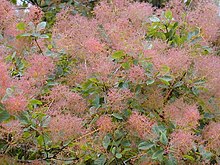Cotinus coggygria, syn. Rhus cotinus, the European smoketree,[1] Eurasian smoketree, smoke tree, smoke bush, Venetian sumach, or dyer's sumach, is a Eurasian species of flowering plant in the family Anacardiaceae.
| Cotinus coggygria | |
|---|---|

| |
| Foliage and seed heads | |
| Scientific classification | |
| Kingdom: | Plantae |
| Clade: | Tracheophytes |
| Clade: | Angiosperms |
| Clade: | Eudicots |
| Clade: | Rosids |
| Order: | Sapindales |
| Family: | Anacardiaceae |
| Genus: | Cotinus |
| Species: | C. coggygria
|
| Binomial name | |
| Cotinus coggygria | |
| Synonyms | |
|
Rhus cotinus | |
Description
editIt is a multiple-branching deciduous shrub growing to 5–7 metres (16–23 feet) tall with an open, spreading, irregular habit, only rarely forming a small tree. The leaves are 3–8 centimetres (1+1⁄4–3+1⁄4 inches) long rounded ovals, green with a waxy glaucous sheen. The autumn colour can be strikingly varied, from peach and yellow to scarlet. The flowers are numerous, produced in large inflorescences 15–30 cm (6–12 in) long; each flower 5–10 millimetres (1⁄4–3⁄8 in) in diameter, with five pale yellow petals. Most of the flowers in each inflorescence abort, elongating into yellowish-pink to pinkish-purple feathery plumes (when viewed en masse these have a wispy 'smoke-like' appearance, hence the common name "smoke tree") which surround the small (2–3 mm or 1⁄16–1⁄8 in) drupaceous fruit that develop.
Fossil record
editMacrofossils of C. coggygria from the early Pliocene epoch have been found in Western Georgia in the Caucasus region.[2]
Distribution and habitat
editThe species is native to a large area from southern Europe, east across central Asia and the Himalayas to northern China.
Uses
editOrnamental plant
editIt is commonly grown as an ornamental plant, with several cultivars available. Many of these have been selected for purple foliage and flowers.
The following cultivars have gained the Royal Horticultural Society's Award of Garden Merit:-
Dyestuff
editThe wood was formerly used to make the yellow dye called young fustic (fisetin),[7] now replaced by synthetic dyes.[8]
The species, along with other members of the sumac family, has been used to make red dyes for textiles including weft-wrapped soumak rugs and bags in the Middle East. The names sumac and soumak likely derive from the Arabic and Syriac word ܣܘܡܩܐ 'summāq', meaning "red".[9]
Gallery
editReferences
edit- ^ NRCS. "European smoketree". PLANTS Database. United States Department of Agriculture (USDA). Retrieved 17 January 2016.
- ^ The History of the Flora and Vegetation of Georgia by Irina Shatilova, Nino Mchedlishvili, Luara Rukhadze, Eliso Kvavadze, Georgian National Museum Institute of Paleobiology, Tbilisi 2011, ISBN 978-9941-9105-3-1
- ^ ""Cotinus" 'Flame'". RHS. Retrieved 5 May 2020.
- ^ ""Cotinus coggygria" Golden Spirit='Ancot'". RHS. Retrieved 5 May 2020.
- ^ ""Cotinus coggygria" 'Royal Purple'". RHS. Retrieved 5 May 2020.
- ^ ""Cotinus coggygria" 'Young Lady'". RHS. Retrieved 5 May 2020.
- ^ Chisholm, Hugh, ed. (1911). . Encyclopædia Britannica. Vol. 11 (11th ed.). Cambridge University Press. p. 375.
- ^ "Young fustic". Britannica.com. Encyclopaedia Britannica. Retrieved 5 May 2020.
- ^ Etymology of Sumac at Etymonline.com and also at "Dictionary English Etymology – Origins – A Short Etymological Dictionary of Modern English Routledge 1958, Parridge)". Archived from the original on 2014-10-12. Retrieved 2017-09-15. and [1]. Etymology of Rhus at Quattrocchi, Umberto (2000). CRC World Dictionary of Plant Names: Common Names, Scientific Names, Eponyms, Synonyms, and Etymology. Vol. IV R-Z. Taylor & Francis US. p. 2306. ISBN 978-0-8493-2678-3.
External links
edit